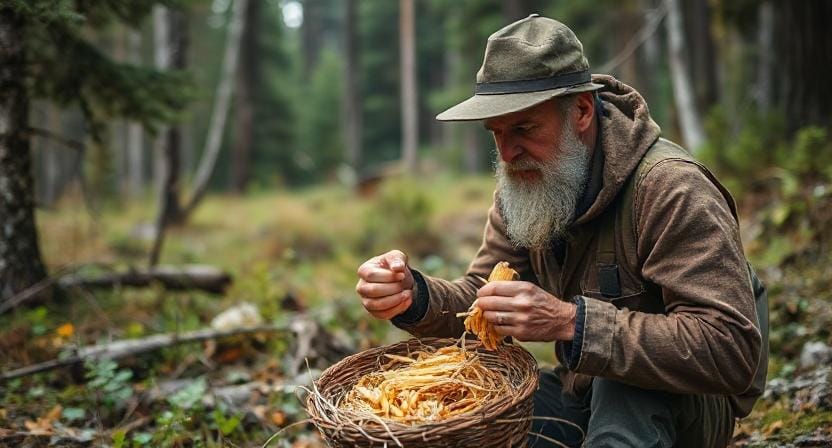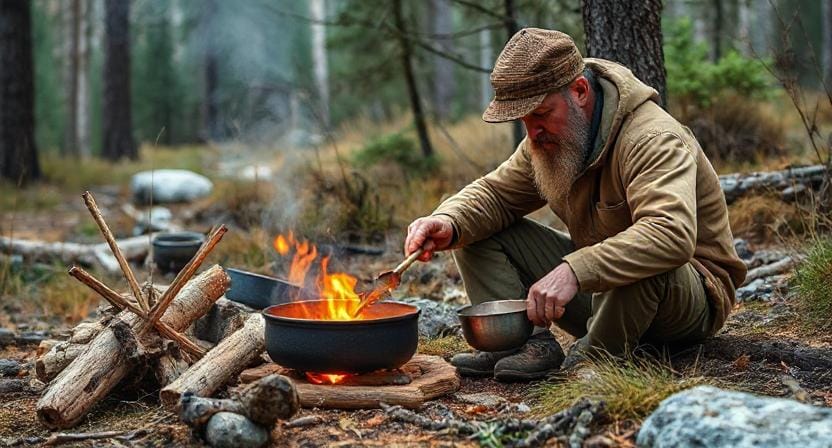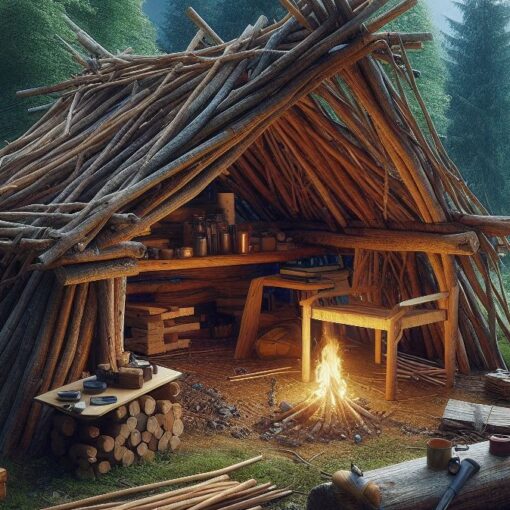Please Note: This post may contain affiliate links. If you click one of them, we may receive a commission at no extra cost to you. As an Amazon Associate, I earn from qualifying purchases.
Top Takeaways and Key Concepts
- Start with familiar edible plants to build confidence and avoid dangerous mistakes.
- Use trusted guides to correctly identify wild plants before eating them.
- Avoid unsafe locations by steering clear of polluted areas and contaminated soil.
- Cook and preserve finds to safely enjoy wild ingredients year-round.
- Forage responsibly by taking only what you need and protecting plant regrowth.
Summary of This Article
This article introduces foraging as a rewarding way to connect with nature while learning to gather edible plants safely. It encourages beginners to start with easy-to-identify plants like dandelions and berries, use field guides for safety, and avoid toxic lookalikes. It discusses the joy of cooking and preserving wild foods, emphasizes sustainable harvesting, and reminds readers to respect nature by leaving enough resources for wildlife and future growth.
Short Video Version of this Article
Have you ever considered about leaving your comfort zone and going into nature’s pantry? Imagine walking through a sunny meadow or a beautiful woodland. There are trees and flowers all around you. It’s like being in a dream. And you know what? While you’re there, you can choose tasty snacks. That’s really cool!
Finding food in the wild is a lot more than simply a fun thing to do. It’s also a great talent to have. It definitely links you to nature. Think about putting berries or wild herbs in your basket. Every time you go outside, it’s like going on a small adventure.
Begin with the basics. First, look for plants you know. For example, dandelions. Those blooms that are bright yellow are more than just attractive. You can eat them! You can use the leaves in salads or tea. There are little gifts from nature all around.
Don’t forget to find out what you’re picking. Some plants may seem the same yet aren’t safe to consume. Those tiny things are important. Look at guides or apps for help.

Going outside and gathering isn’t just for food. It’s also about making connections with the world around you. You’ll notice things you’ve never seen before. The how the light shines through the foliage. The sound of a stream nearby that is gentle. This also feeds your soul.
Let’s be honest: there might be bugs and dirty shoes along the way. But isn’t that part of the fun? Every tiny problem makes it more fun. It’s like little exams from nature. You can do it!
And what do you do when you find something good? Eating what you gathered is very satisfying. You are proud of what you have done. And it’s even better when you share what you find with friends or family. Everyone enjoys a good story about how to get food in the wild.
So why not give it a shot? Go outside, look about, and make Mother Nature your own grocery store. Adventure is waiting for you!
Understanding Foraging: The Basics of Gathering

It’s important to know what you’re getting into before you go out and forage. Picking random plants isn’t enough for foraging; you need to know about and appreciate nature. It’s like looking for treasure, but this treasure is food!
Learn about the plants that grow around you first. It’s like finding buried gems! There are a lot of tools, including field guides and useful applications, that can assist you identify plants that you can eat. You don’t want to get a tasty fruit mixed up with a sneaky poisonous one, do you? So, get a book of instructions. Get comfortable with the photographs and learn about the plants that are growing around you.
It can be really exciting to find plants that you can eat. Think about seeing something you can really eat. That moment seems like a small win!
You may make this even better by joining local foraging organizations or classes. You can meet folks that enjoy nature just as you do. You can tell stories and obtain useful advice. Experienced foragers have a lot of information to give. They can tell you what to look for and what to stay away from.
Being among other people might sometimes help you learn. When you find something funny, like a plant that seems like it could be eaten but isn’t, you can laugh together. You won’t be alone on this trip!
Also, it’s always great to explore with pals! It’s nice to have someone to talk to about what you’ve found. You might find a new favorite plant together.
Getting involved in your community can also help. You might learn about markets or activities in your area. Some localities even have potlucks when people bring wild edibles. That would be really great!
So, go ahead and take those first steps. Learn, make connections, and experience the excitement of foraging. There are a lot of great things in nature, and you’re about to learn a lot of tasty secrets!
Essential Edible Plants: What to Look For

Now that you know the basics, let’s look at some common plants that you might be able to eat that are around. By the way, I think you’ll be amazed at how many tasty choices there are!
Did you realize that dandelions are more than simply annoying weeds? Yes! You may eat every part of them. You can use their blooms, leaves, and roots. They make good drinks and salads. Who would have believed that those little yellow blossoms could be so wonderful for you?
Another interesting thing to find is wild garlic. You could smell it strongly when you go through woodlands or fields in the spring. It’s like spice from Mother Nature! You can use it in many different kinds of food. What’s the best part? It’s free! Just choose some and enjoy.
Let’s discuss about fruits. You can discover different kinds of berries on paths or in prickly bushes during the summer. They taste great. Before you eat them, be sure you know what they are. Okay, always check again.
And then there are the nuts. Have you ever thought about acorns? They might not look good at first, but you can turn them into flour after you process them. That’s quite cool! Walnuts and hazelnuts are very tasty, especially in the fall. It seems like a food from nature just ready to be grabbed.
It’s important to think about the seasons. Plants come and leave at different times of the year. So, paying attention to what’s accessible can help you find the best things. Some seasons are great for berries, while others are all about nuts.
It’s fun to think about all the great things that are waiting for you outside. Finding food in nature may make a simple walk into an exciting experience! Just remember to have fun and learn as you go.
Safety First: Know What Not to Eat

Now let’s speak about safety, because it’s just as important to know what not to eat as it is to know what to eat. Some wild plants can actually hurt you badly if you eat them.
Don’t touch anything you don’t know for sure is safe. Stick with species you know until you’re sure you can handle them. Always wash any food you gather well before eating it. This gets rid of dirt and other germs.
It’s a great idea to start with just a little bit when you’re trying new cuisine. You could, like, take a small nibble or two. If your stomach doesn’t like it, you won’t feel too bad. I mean, it happens to all of us at some point, right? It’s better to be cautious than sorry!
And if you ever see a plant that you’re not sure about, even after doing some research, simply skip it. Really. Believe in your gut! It’s alright to leave if something doesn’t seem right. Nature can be beautiful, but it can also be hard. You can always find something different next time.
Being careful makes it more pleasurable. There are a lot of delicious things out there for you to eat. Don’t rush things and pay attention to what your body is telling you. It’s about having fun on the trip without any stress!
The Joys of Cooking Your Finds

Okay then! What do you do now that you’ve found some cool stuff in the wild? It’s time to cook them and enjoy that hard-earned meal! A lot of people say that cooking using ingredients they found themselves is more satisfying than cooking with things they bought at the supermarket.
Your taste senses will thank you later if you add fresh greens to salads or sauté mushrooms over spaghetti. Another great choice is dandelion tea. If you want it to be sweet, soak the leaves with honey.
What a great thing berries are! While you’re picking berries, think of creating a cobbler or some tasty jams. It’s a great way to taste those fresh flavors. Not to mention sharing with pals at a party? Total victory! Imagine everyone loving what you made. Isn’t that nice?
But hold on, there’s more! You can also save those delicious berries for later. It’s easy to dry herbs, and it maintains all the flavor inside. Just think about how great it would be to use your own dried herbs in winter dinners. It feels nice!
Another fantastic idea is to freeze fruits. Simply wash them, put them in a bag, and put them in the freezer. When it’s cold outside and you want summer, you’ll have a little sweetness waiting for you.
You may enjoy those great flavors all year long. It makes every season unique! It’s much more pleasure to treat yourself or share with others. So, have fun and be creative!
Respecting Nature: Sustainable Foraging Practices
It is really vital to forage in a way that is good for the environment. You could say that nature provides us a lot, but we have to be careful. We want youngsters in the future, like your friends or perhaps your own kids, to enjoy all of these treats too.
Get only what you need. Don’t pick all the mushrooms if you see a patch of them. Leave some behind. This way, the plants can keep growing and the animals can eat. It’s like giving, right?
Use scissors to cut the herbs. Instead of pulling them out, just give them a tiny cut. That makes them want to come back. It’s a little bit wonderful how nature works that way.
And let’s not keep this a secret. Talk to other people about how to harvest in a way that is safe. Tell others what you learn. It makes people care more about our lovely world. We all want to keep it safe so we can enjoy it for a long time.
Foraging is a safe and rewarding way to gather wild edible plants when done with proper knowledge and caution. Beginners should start with familiar plants, use trusted identification guides, avoid polluted areas, and harvest responsibly. Cooking and preserving wild foods adds value to the experience while sustainable foraging protects nature for the future.
Frequently Asked Questions
What is the safest way to start learning foraging?
The safest way to begin foraging is to start with easily identifiable edible plants like dandelions or blackberries and verify each plant using a trusted field guide or app.
How can I avoid poisonous plants while foraging?
Avoid poisonous plants by learning common toxic lookalikes, double-checking plant features like leaf shape and smell, and never eating anything unless you are completely sure it is safe.
Where should I avoid foraging?
You should avoid foraging near roads, industrial sites, chemically treated lawns, and polluted water sources because plants in these areas may be contaminated.
Can I forage all year long?
Yes, foraging is possible year-round, but available plants vary by season. Spring offers greens and flowers, summer provides berries, fall brings nuts and seeds, and winter allows for limited roots and evergreens.
How do I store and preserve wild foods?
You can preserve wild foods by drying herbs, freezing berries, making teas, or creating jams and sauces to enjoy your harvest long after gathering.
Is it legal to forage in any location?
Foraging laws vary by location, so always check local regulations. Some parks allow small personal harvesting, while others prohibit it to protect native plant life.
What are the rules of sustainable foraging?
Sustainable foraging means taking only what you need, leaving enough plants to regrow, avoiding uprooting entire plants, and respecting wildlife that depends on natural food sources.
Suggested Resources:
Edible Wild Plants
https://www.ediblewildplants.com
The Ultimate Guide To Foraging
https://www.theultimateguidetoforaging.com
Wild Foods Cookbook
https://www.wildfoodscookbook.com

Kevin Collier is a seasoned outdoor enthusiast and writer for Trekbug.com, specializing in outdoor adventures, survival strategies, and prepping insights. With a deep love for nature and a commitment to self-sufficiency, Kevin empowers readers to embrace the wilderness confidently. He shares valuable tips, practical techniques, and inspiring stories, helping both novice and experienced adventurers develop essential skills for surviving and thriving in the great outdoors.





